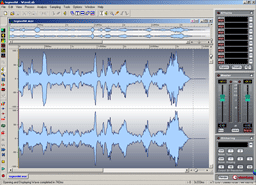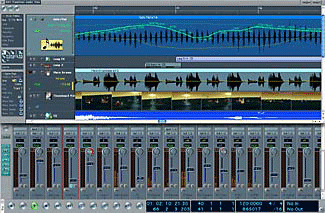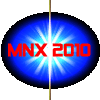| |
MNX2010 PC Audio Sites - Software :
 Introduction Software
Introduction Software
Software is developing rapidly and improvements are made with a very fast rate. There where rumours that Steinberg would stop upgrading Cubase to spend more time developing Nuendo. But apparently Steinberg continues developing Cubase more as a "composer program" while Nuendo becomes more and more a Pro-Tools clone (multi channel real time audio streaming). Most audio software can be divided into two groups : the arrangement programs like Cakewalk, Cubase, Emagic Notator & Logic Audio Pro, and for audio recording programs like Nuendo, Logic Audio Pro and Pro-Tools. Off course there do exist other similar programs, but these are not to be compared with these Software Giants. Cubase, Notator en Pro-Tools originated on the Atari (link MNX Atari Site), a computer I still work with.
 Cubase, the best sold music program ever.
Cubase, the best sold music program ever.
The first Cubase Program on the Atari was the 1.0 version, which followed the PRO12 version. Both didn't work very well. PRO12 was a totally illogic program and Cubase 1.0 crashed every few minutes. It was really tricky to record a midi track and to play a second layer simultaneously.
With the introduction of Cubase 1.5 the trend was set, this was the basis on which the Cubase (and more music programs) of nowadays are based on.
The 2.0 version is an improved and bug free version, the most stable and the best midi program ever made for Atari.
After a special version for the Atari STE & TT, Cubase 2.01, Steinberg developed the first Cubase audio version, the father of all VST versions for the Falcon (the first 8 channel harddisk recordings computer). With this version, the foundation was created for all later developments in the area of audio recording. The last version on Atari ST was the 3.01 version, a sort of a beta version for the first PC version 1.0.
With the arriving of Windows 95 and its large multimedia possibilities, soon the first Cubase audio for PC appeared, which also had full midi support.
From that time on, no real big changes where added to Cubase. Perhaps some details, functions and possibilities are improved but in general it stayed the same.
The VST32 versions gave Cubase the final appearance it still has nowadays, with the VST plugins and VST-Instruments. Cubase has always been the absolute top in quality music software, although Cubase has become less comprehensible nowadays, because of the overwhelming possibilities, additions and extra's.
With the arriving of the SX versions, Cubase has to decide what to put in their program and what not, because it's impossible to put it all in one program!
The possibilities for making arrangements can be made clearer, more user-friendly, more efficient, and need more structure. Also the built-in possibilities for working with samples can be better, simpler and more effective and efficient. Perhaps a bit more like Ableton Live (See link). Because of the problems caused by overdoses of plugins and Instruments, also more attention should be given to the management of those extras.
 Cubase counterpart : Notator
Cubase counterpart : Notator
I don't know much about Notator, I sometimes used this program on the Atari(1.0 version) but it didn't suite me well, yet still a lot of people prefer this program. The system is more based on working with patterns, what reminds me of old Amiga music programs. Advantage here is a better integration of MIDI System Exclusive and effects, the sounds are loaded before you play the patterns.
Nowadays Notator (Logic Audio Platinum) has become a real giant and is often used by musicians and arrangers/composers.
In some ways it is even more developed than Cubase : it has more possibilities in the sampling area, there is more oversight, no important functions are hidden beyond minuscule buttons. The layout and design of the program are better, which is not only better to look at!
Specially designed Hardware
At last Steinberg introduced their Cubase PCI soundcard, but it actually isn't that spectacular after all. In fact they shouldn't have bothered at all, because for the same amount of money there are better soundcards available. Perhaps they were aware of that fact, considering the considerable delay in the final introduction. It surprised me that Steinberg didn't come with something special after all that time, obviously they aren't truly motivated. And don't mention HUDSON at all, there exist several alternative remote controls with midi or USB connector, although they're very expensive. If you're a little bit technical, you'd better build it yourself for little money.
 Nuendo from Steinberg, in this case, do have a professional hardware line.
It's obvious that with this concept Steinberg tries to compete with the Pro-Tools systems.
The concepts look alike, with one big exception : it certainly is much cheaper than Pro-Tools. Another participant is Logic Audio Platium who is also offering a totally digital system. It looks very flashy, but I guess it will be not cheap.
Nuendo from Steinberg, in this case, do have a professional hardware line.
It's obvious that with this concept Steinberg tries to compete with the Pro-Tools systems.
The concepts look alike, with one big exception : it certainly is much cheaper than Pro-Tools. Another participant is Logic Audio Platium who is also offering a totally digital system. It looks very flashy, but I guess it will be not cheap.
Next to the digital studio's working with Pro-Tools systems, there are also studio's running a Nuendo system. Besides cheaper it's also more fine-tuned for the Cubase users.
Nuendo, Logic Audio and the Pro-Tools hardware support the modern multi layer ADAT, analogue and Optical ADAT, with possibilities to synchronize together. But for professionals Pro-Tools is to prefer : it is stable, professional and used more often in audio, film and video studio's.
That makes it hard for Nuendo and Logic Audio Platinum to compete with Pro-Tools here, and that's why they don't have a similar position yet. But considering their relatively low prices this might well have in the future.
For home-recording cheaper programs are more suitable, because this group of people don't have the financial means to invest in these very expensive systems.
Also Nuendo is compatible with the regularly used VST - plugins and instruments, of which a large quantity exists today. All of that makes Nuendo a potential competitor for Pro-Tools.
That's why Pro-Tools introduced a Lite version, more concentrating on the home studio user, and have an older version to download for free from there website. That is obviously meant as a tactic to also bind the less wealthy home studio users.
Special hardware for software
The hardware modules of Pro-Tools are of the absolute highest quality, but as you have probably already guessed, the prices are also the highest. Therefore they're not really meant for home-recording, but then again, even the Hardware Modules of Nuendo are way too expensive as well. Maybe it is even better, for that money, to buy a RME Hammerfall with 3 3 Optical ADAT's and a MOTU RME module with more or less the same quality (See hardware).
|



 Introduction Software
Introduction Software
 Cubase, the best sold music program ever.
Cubase, the best sold music program ever.
 Cubase counterpart : Notator
Cubase counterpart : Notator
 Nuendo from Steinberg, in this case, do have a professional hardware line.
It's obvious that with this concept Steinberg tries to compete with the Pro-Tools systems.
The concepts look alike, with one big exception : it certainly is much cheaper than Pro-Tools. Another participant is Logic Audio Platium who is also offering a totally digital system. It looks very flashy, but I guess it will be not cheap.
Nuendo from Steinberg, in this case, do have a professional hardware line.
It's obvious that with this concept Steinberg tries to compete with the Pro-Tools systems.
The concepts look alike, with one big exception : it certainly is much cheaper than Pro-Tools. Another participant is Logic Audio Platium who is also offering a totally digital system. It looks very flashy, but I guess it will be not cheap.
